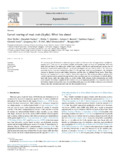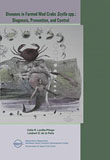Formalin as an alternative to trifluralin as prophylaxis against fungal infection in mud crab Scylla serrata (Forsskål) larvae
- Global styles
- MLA
- Vancouver
- Elsevier - Harvard
- APA
- Help

View/
Date
2007Page views
1,900ASFA keyword
AGROVOC keyword
Taxonomic term
Metadata
Show full item record
Share
Abstract
The toxicity of formalin and trifluralin to the larval stages of the mud crab Scylla serrata was compared in a static bioassay. Prophylactic doses of 5, 10, 15, 20 and 25 μg L−1 formalin and 0.05, 0.1, 0.2, 0.4 and 0.8 μg L−1 trifluralin were used. Toxicity was assessed on the basis of survival of larvae after 24, 48, 72 and 96 h exposure to the test chemicals and metamorphosis to the next larval stage. Result shows that larval survival in all stages was significantly reduced at concentrations of 20 and 25 μg L−1 formalin whereas larvae were able to tolerate all trifluralin treatments. However, larvae became more tolerant to high formalin concentrations as the larval stage progressed. Survival was better at 5, 10 and 15 μg L−1 formalin and in all trifluralin treatments than the control in almost all the larval stages. Faster metamorphosis was observed at 5 and 10 μg L−1 formalin and 0.05, 0.1 and 0.2 μg L−1 trifluralin concentrations. Doses of formalin and trifluralin obtained from the toxicity experiments were applied as prophylaxis to newly hatched larvae in white plastic basins. Prophylactic doses of 5 and 10 μg L−1 formalin and 0.05 and 0.1 μg L−1 trifluralin applied every other day were found to be effective in enhancing survival and larval development to megalopa compared with control. However, no megalopae survived to crab instar in all formalin treatments. Although the use of fungicides in rearing systems resulted in higher survival compared with controls, other strategies (i.e. maintenance of good water quality and hygienic practices in the hatchery) should be further investigated as an alternative to the use of chemicals in hatcheries.
Suggested Citation
de Pedro, J. B., Quinitio, E. T., & Parado-Estepa, F. D. (2007). Formalin as an alternative to trifluralin as prophylaxis against fungal infection in mud crab Scylla serrata (Forsskål) larvae. Aquaculture Research , 38(14), 1554-1562. https://doi.org/10.1111/j.1365-2109.2007.01723.x
Type
ArticleISSN
1355-557X; 1365-2109Collections
- Journal Articles [1258]
Related items
Showing items related by title, author, creator and subject.
-
Larval rearing of mud crab (Scylla): What lies ahead
Waiho, Khor; Fazhan, Hanafiah; Quinitio, Emilia T. ; Baylon, Juliana C.; Fujaya, Yushinta; Azmie, Ghazali; Wu, Qingyang; Shi, Xi; Ikhwanuddin, Mhd; Ma, Hongyu (Elsevier, 2018)
The increasing global demand for mud crabs (genus Scylla) and threats to the wild populations highlight the urgency of fully rearing them in captivity. Despite considerable progress in mud crab production, most crab farms ...
; Baylon, Juliana C.; Fujaya, Yushinta; Azmie, Ghazali; Wu, Qingyang; Shi, Xi; Ikhwanuddin, Mhd; Ma, Hongyu (Elsevier, 2018)
The increasing global demand for mud crabs (genus Scylla) and threats to the wild populations highlight the urgency of fully rearing them in captivity. Despite considerable progress in mud crab production, most crab farms ... -
Diseases in farmed mud crabs Scylla spp.: Diagnosis, prevention, and control.
Lavilla-Pitogo, Celia R.; de la Peña, Leobert D. (Aquaculture Dept., Southeast Asian Fisheries Development Center, 2004-12)Aquaculture production has suffered many set-backs due to the occurrence of diseases. Many of the diseases are caused by infectious organisms that are difficult to detect and need sophisticated instruments for diagnosis, ... -
Mud crab pond and pen culture
Rodriguez, Eduard M. (University of the Philippines Aquaculture Society, Inc, 2001)




